If you know me, then you know when I have a little too much time on my hands — or really, any time at all on my hands — Pinterest is favorite destination for mindless scrolling. I’m the girl sitting in front of you in your ENGL lecture scrolling through endless “Fixer Upper” kitchen remodels and diving down rabbit holes of inspirational quotes.
And while you might think Pinterest is dumb, it does one thing very, very well. Pinterest is a constantly updated record of our trends, fads and even beliefs. This year, amidst the #MeToo and Time’s Up movements championing equal rights and protection for women and countless other campaigns breaking down gendered social constructs, Pinterest has been flooded with female empowerment propaganda. Finally, we are recognizing and praising the strength of women with pink script proudly declaring, “The Future Is Female.”
My favorite of these quotes reads, “Here’s to strong women. May we know them. May we be them. May we raise them.”
As the proud daughter of a single mom who worked a man’s job — a state-employed prosecutor for criminal cases — for a decade, I know what strength looks like in a powerful female. Women have a brilliant and beautiful strength that is unique to their circumstances and struggles, and I love that we — as a society — are beginning to realize and celebrate what’s been hidden under the glass wall in previous generations.
However, I felt as though I hit a different wall this semester. It happened when I entered the University North Grounds Gym and picked up a barbell to squat.
Now, I’ve never been a “gym girl.” I love to ride horses, but when I couldn’t handle the time commitment, I just kind of stopped exercising. But just before spring break, my best friend began weight training with Starting Strength — a strength training system designed to improve your strength and health using basic barbell exercises like the squat, deadlift and bench press. To be supportive, I decided to try to run my own linear progression where I would add weight to the bar for each of those exercises each week until I couldn’t lift any more. What could it hurt? Well, what I didn’t know was how much it could help.
What started as little more than an ambition to encourage my best friend on his journey started one for myself that I would have never in a hundred years predicted. I kind of fell in love with deadlifting. And by kind of, I mean definitely.
There is something absolutely addictive about setting a new goal each week and working to lift more weight than you’ve ever personally lifted before — even if that’s only 45 pounds, which, full disclosure, for me it was. However, what I really fell in love with was the end goal of strength training — which is simply that, strength. Not a beach body, or losing 10 pounds, or being “toned,” but functional strength — the kind of holistic strength that enables you to help push a car out of a ditch or pick up your kids one day when you’re old. It’s not image based. It’s ability based. And I, even as a petite blonde girl, wanted to be able to do more. I want to be strong.
I mean, this is the age of women being strong, right? Not so fast.
What I quickly realized is that our generation and culture has made incredible progress with championing the inner strength of women. We celebrate women who are fierce, tenacious and determined — rightfully so. This is a huge victory. However, physical strength is a whole other can of worms.
As soon as I started lifting, men and women, strangers and friends alike started asking me if I was trying to “bulk up” and “get big,” showing me what I was presumably going to look like after benching 25 pounds by inflating their chest and standing with a domineering posture. Boys teased me for attempting to build muscle mass. Girls told me that they didn’t want to be strong. They just wanted to be skinny and toned — they didn’t want to look “masculine.” Everyone warned me, some jokingly and some seriously, that I was going to end up looking like a freak bodybuilder.
Here’s the thing — strength is not masculine. I have the same number of muscles on my female body as a man has on his male body. They are made of the same muscle tissue. Muscles are not male or female — muscles are human.
Training my body with weights to strengthen the muscles I naturally have will not transform me into a man. In fact, it will make everything about my female body more defined. I would need some serious drugs to grow muscle in a way that would actually take up significantly more space in a room. That’s just not going to happen.
If we, as women, don’t want to be strong because we think it will make us look “manly,” then that says something about the way our generation continues to view strength. We are still struggling to break strength out of a gendered role and claim it as an incredible characteristic for all of us. We are still struggling with the incredibly crippling social construct that tells us that men are supposed to be strong and women are supposed to be weak.
Inner and outer strength go hand in hand. In my personal experience, the more I surprised myself with the amount of weight I was able to add to the bar and conquer, the more confident I felt as I faced difficult obstacles and heavy circumstances in my personal life. For the first time, I thought I might be stronger than I believed in those situations too. And that was a game changer for my overall mental health.
If we want women to know they are free to be bosses, we can’t shame them when they try to touch a barbell and tap into that aspect of their strength as well. So let’s keep celebrating strength — for all people, inclusively and holistically, mentally and physically, emotionally and relationally. Men and women alike.
Sarah Ashman is a Life Columnist for The Cavalier Daily. She can be reached at life@cavalierdaily.com.





